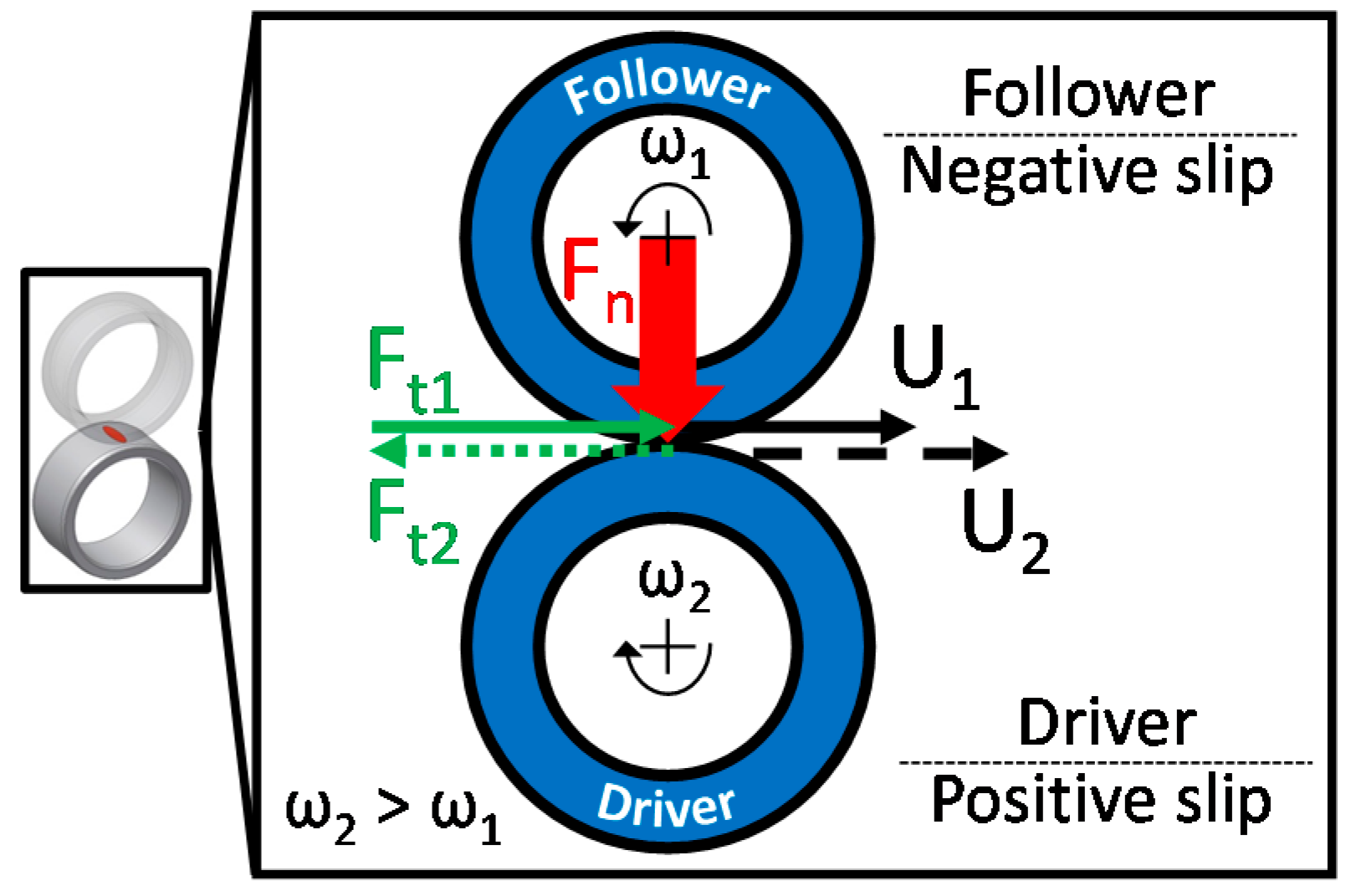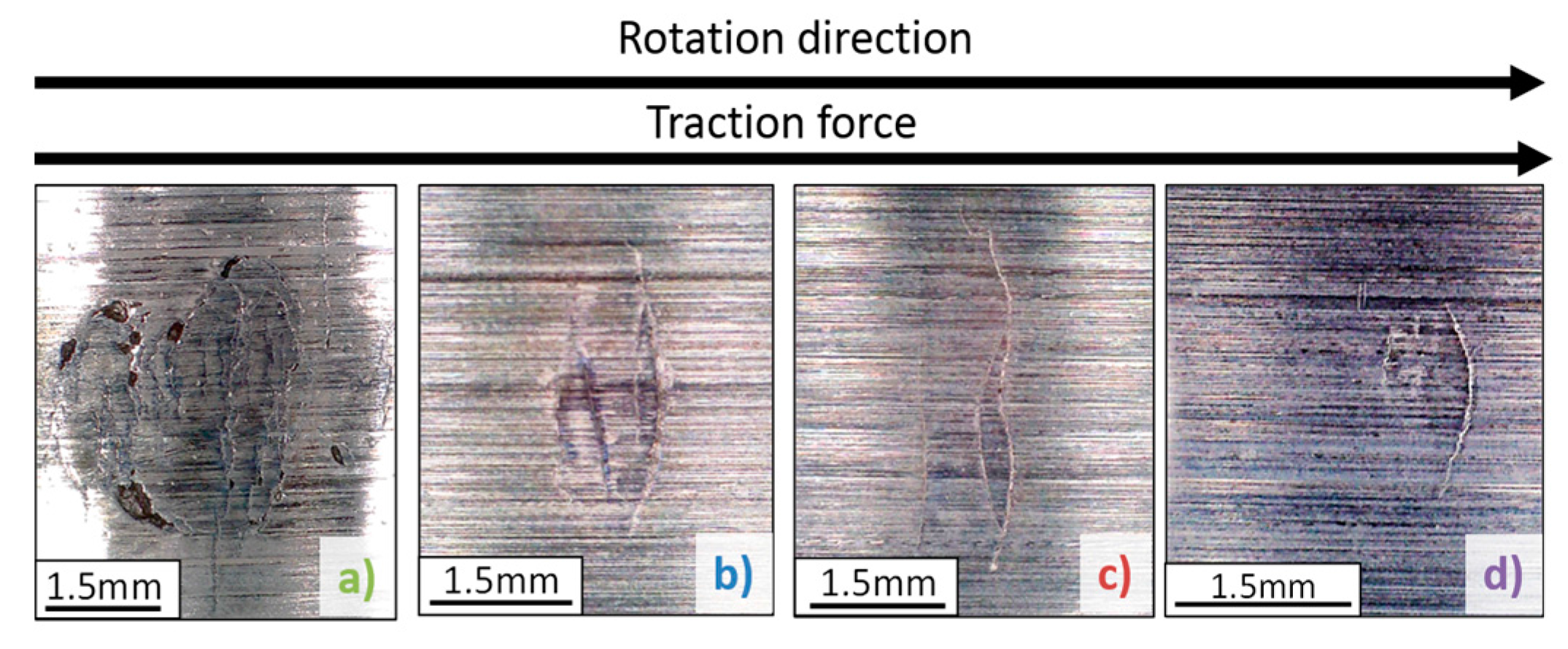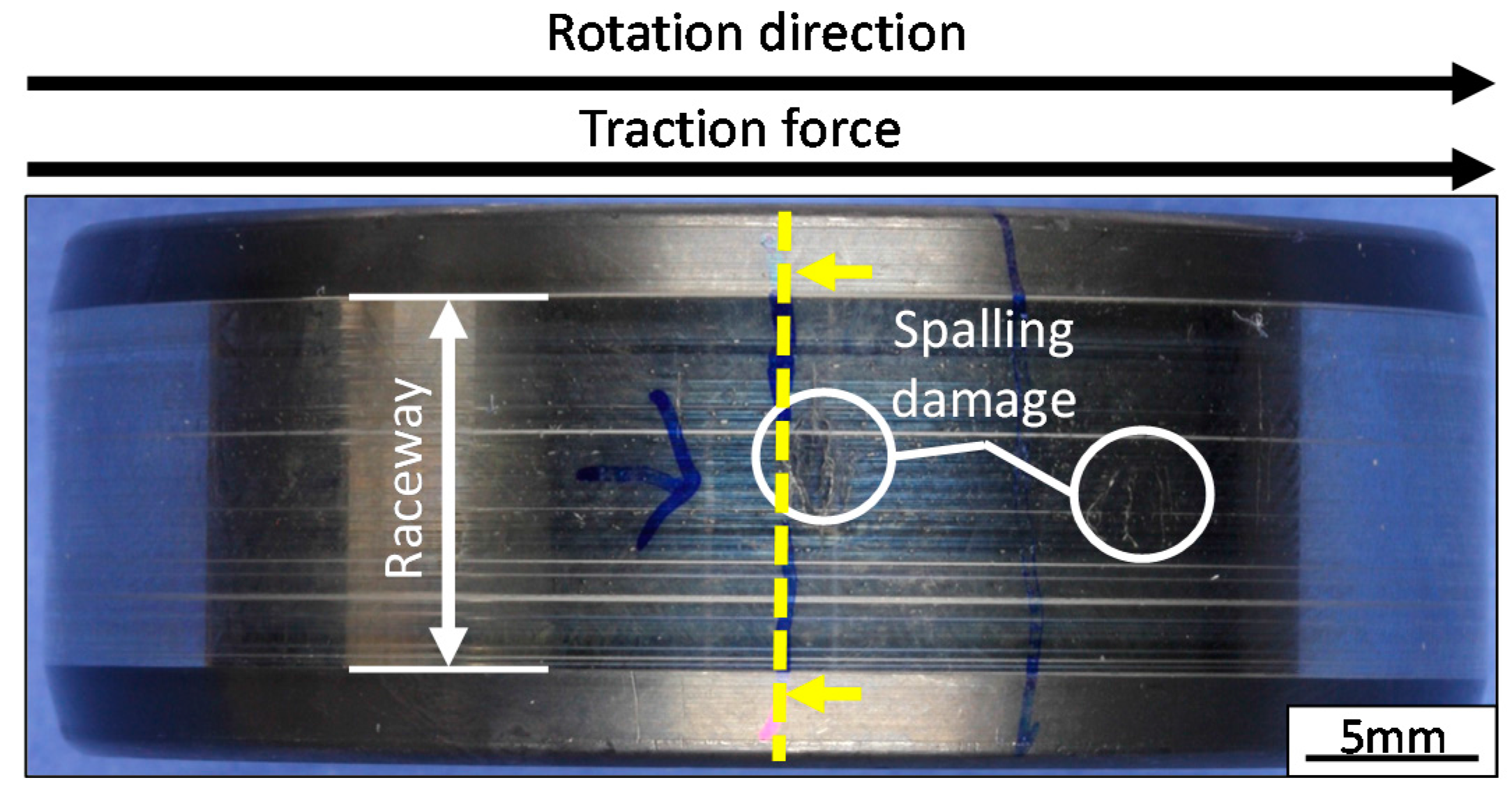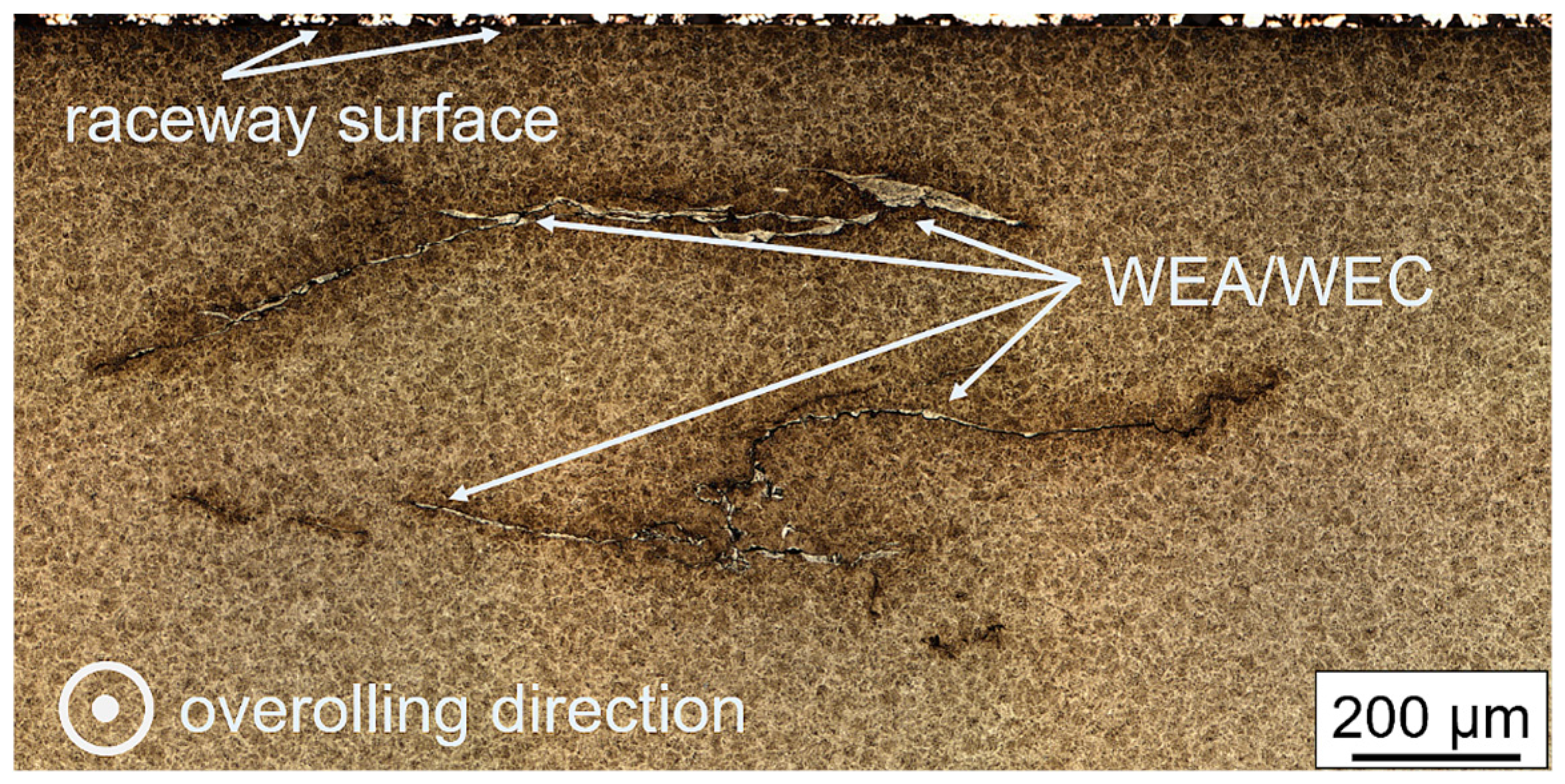Influence of Slip and Lubrication Regime on the Formation of White Etching Cracks on a Two-Disc Test Rig †
Abstract
:1. Introduction
2. Materials and Methods
2.1. Lubricant
2.2. Two-Disc Test Rig
2.3. Calculation Methods
2.4. Test Methods
3. Results
3.1. Influence of Sliding under Full Fluid Lubrication
3.2. Influence of Sliding under Boundary Lubrication
3.3. Identification of WEA/WEC
4. Discussion
4.1. Influence of Lubrication Regime
4.2. Influence of Sliding and Slip Type
5. Conclusions
- (1)
- The prevailing lubrication conditions seem to have a dominant influence on the formation of WEC under rolling contact. Tests under full fluid lubrication (λ > 3) did not show any material damage (after the pre-defined running times), whereas WEC formation occur on tests running under boundary lubrication conditions (λ < 1).
- (2)
- Maintaining a roughly constant SRR while increasing the λ-value from 0.2 to 0.5 and 0.7 leads to an increase of the running time by 11% and 54% respectively.
- (3)
- By decreasing the SRR from 21.0% to 15% and maintaining the same λ-value, the running time decreased (against the expectations) by 20%.
- (4)
- The slip type influences the extent of the WEA/WEC damage. Whereas the test rings that experienced negative slip showed large WEA/WEC networks—which spread mainly parallel to the raceway surface—the rings running positive slip showed considerably less WEA/WEC.
Acknowledgments
Author Contributions
Conflicts of Interest
References
- Evans, M.H. An updated review: White etching cracks (WECs) and axial cracks in wind turbine gearbox bearings. Mater. Sci. Technol. 2016, 32, 1133–1169. [Google Scholar] [CrossRef]
- Evans, M.H. White Structure Flanking Failure in Bearings under Rolling Contact Fatigue. Ph.D. Thesis, University of Southampton, Southampton, UK, 2013. [Google Scholar]
- Diederichs, A.M.; Schwedt, A.; Mayer, J.; Dreifert, T. Electron microscopy analysis of structural changes within white etching areas. Mater. Sci. Technol. 2016, 32, 1683–1693. [Google Scholar] [CrossRef]
- Hiraoka, K.; Nagao, M.; Isomoto, T. Study on flaking process in bearings by white etching area generation. J. ASTM Int. 2006, 3, 1–7. [Google Scholar] [CrossRef]
- Lai, J.; Stadler, K. Investigation on the mechanisms of white etching cracks (WEC) formation in rolling contact fatigue and identification of a root cause for bearing premature failure. Wear 2016, 364–365, 244–256. [Google Scholar] [CrossRef]
- Greco, A.; Shengb, S.; Kellerb, J.; Erdemira, A. Material wear and fatigue in wind turbine systems. Wear 2013, 302, 1583–1591. [Google Scholar] [CrossRef]
- Li, S.; Su, Y.; Shu, X.; Chen, J. Microstructural evolution in bearing steel under rolling contact fatigue. Wear 2017, 380–381, 146–153. [Google Scholar] [CrossRef]
- Holweger, W.; Wolf, M.; Merk, D.; Blass, T.; Goss, M.; Loos, J.; Barteldes, S.; Jakovics, A. White etching crack root cause investigation. Tribol. Trans. 2014, 58, 56–59. [Google Scholar] [CrossRef]
- Ruellan, A.; Ville, F.; Lieber, X.; Arnaudon, A.; Girodin, D. Understanding white etching cracks in rolling element bearings: The effect of hydrogen charging on the formation mechanisms. J. Eng. Tribol. 2014, 228, 1252–1265. [Google Scholar] [CrossRef]
- Gould, B.; Greco, A. Investigating the Process of White Etching Crack Initiation in Bearing Steel. Tribol. Lett. 2016, 62, 26. [Google Scholar] [CrossRef]
- Loos, J.; Bergmann, I.; Goss, M. Influence of currents from electro-static charges on WEC formation in rolling bearings. Tribol. Trans. 2016, 59, 865–875. [Google Scholar] [CrossRef]
- Danielsen, H.K.; Gutiérrez Guzmánb, F.; Dahl, K.V.; Li, Y.J.; Wu, J.; Jacobs, G.; Burghardt, G.; Faster, S.; Alimadadih, H.; Goto, S.; et al. Multiscale characterization of White Etching Cracks (WEC) in a 100Cr6 bearing from a thrust bearing test rig. Wear 2016, 370–371, 73–82. [Google Scholar] [CrossRef]
- Dowson, D.; Higginson, G.R. Elasto Hydrodynamic Lubrication; Pergamon Press: Oxford, UK, 1977. [Google Scholar]
- Murakami, Y.; Kaneta, M.; Yatsuzuka, H. Analysis of Surface Crack Propagation in Lubricated Rolling Contact. ASLE Trans. 1985, 28, 60–68. [Google Scholar] [CrossRef]
- Kaneta, M.; Yatsuzuka, H.; Murakami, Y. Mechanism of Crack Growth in Lubricated Rolling/Sliding Contact. ASLE Trans. 1985, 28, 407–414. [Google Scholar] [CrossRef]
- Soda, N.; Yamamoto, T. Effect of Tangential Traction and Roughness on Crack Initiation/Propagation during Rolling Contact. ASLE Trans. 1982, 25, 198–206. [Google Scholar] [CrossRef]
- Sommer, K.; Heinz, R.; Schoefer, J. Verschleiß Metallischer Werkstoffe-Erscheinungsformen Sicher Beurteilen; Vieweg+Teubner Verlag, Springer Fachmedien Wiesbaden GmbH: Wiesbaden, Germany, 2010. [Google Scholar]
- Kruhöffer, W.; Loos, J. WEC Formation in Rolling Bearings under Mixed Friction: Influences and “Friction Energy Accumulation” as Indicator. Tribol. Trans. 2017, 60, 516–529. [Google Scholar] [CrossRef]
- Kohara, M.; Kawamura, T.; Egami, M. Study on Mechanism of Hydrogen Generation from Lubricants. Tribol. Trans. 2006, 49, 53–60. [Google Scholar] [CrossRef]






| S (ppm) | P (ppm) | Zn (ppm) | Ca (ppm) | Mg (ppm) |
|---|---|---|---|---|
| 8343 | 512 | 616 | 39 | 1950 |
| Test | PHertz (GPa) | ϑOil (°C) | SRR (%) | λ (-) | |
|---|---|---|---|---|---|
| Fluid lubrication | 1 | 1.2 | 60 | 0 | 10.3 |
| 2 | 8.3 | 15.4 | |||
| 3 | 8.3 | 7.1 | |||
| 4 | 12.7 | 19.1 | |||
| Boundary lubrication | 5 | 1.4 | 70 | 12.8 | 0.78 |
| 6 | 100 | 23.5 | 0.24 | ||
| 7 | 21.0 | 0.72 | |||
| 8 | 15.0 | 0.71 | |||
| 9 | 21.0 | 0.49 |
| Test | Load Cycles (Mio.) | Results from Metallography | ||
|---|---|---|---|---|
| - | Follower | Driver | Follower | Driver |
| 1 | 40.9 | 40.9 | No WEC | No WEC |
| 2 | 37.6 | 40.9 | No WEC | No WEC |
| 3 | 39.3 | 42.7 | N.A. | N.A. |
| 4 | 35.5 | 40.3 | N.A. | No WEC |
| Test | Load Cycles (Mio.) | Results from Metallography | ||
|---|---|---|---|---|
| - | Follower | Driver | Follower | Driver |
| 5 | 10.5 | 12.0 | No WEC | No WEC |
| 6 | 28.5 | 36.1 | WEC (Spalling) | Axial Cracks + WEC |
| 7 | 48.6 | 60.0 | WEC (Spalling) | N.A. (No Spalling) |
| 8 | 38.5 | 44.7 | WEC (Spalling) | N.A. (No Spalling) |
| 9 | 31.6 | 39.0 | WEC (Spalling) | WEC (Spalling) |
© 2018 by the authors. Licensee MDPI, Basel, Switzerland. This article is an open access article distributed under the terms and conditions of the Creative Commons Attribution (CC BY) license (http://creativecommons.org/licenses/by/4.0/).
Share and Cite
Gutiérrez Guzmán, F.; Oezel, M.O.; Jacobs, G.; Burghardt, G.; Broeckmann, C.; Janitzky, T. Influence of Slip and Lubrication Regime on the Formation of White Etching Cracks on a Two-Disc Test Rig. Lubricants 2018, 6, 8. https://doi.org/10.3390/lubricants6010008
Gutiérrez Guzmán F, Oezel MO, Jacobs G, Burghardt G, Broeckmann C, Janitzky T. Influence of Slip and Lubrication Regime on the Formation of White Etching Cracks on a Two-Disc Test Rig. Lubricants. 2018; 6(1):8. https://doi.org/10.3390/lubricants6010008
Chicago/Turabian StyleGutiérrez Guzmán, Francisco, Mehmet Ozan Oezel, Georg Jacobs, Gero Burghardt, Christoph Broeckmann, and Thomas Janitzky. 2018. "Influence of Slip and Lubrication Regime on the Formation of White Etching Cracks on a Two-Disc Test Rig" Lubricants 6, no. 1: 8. https://doi.org/10.3390/lubricants6010008




